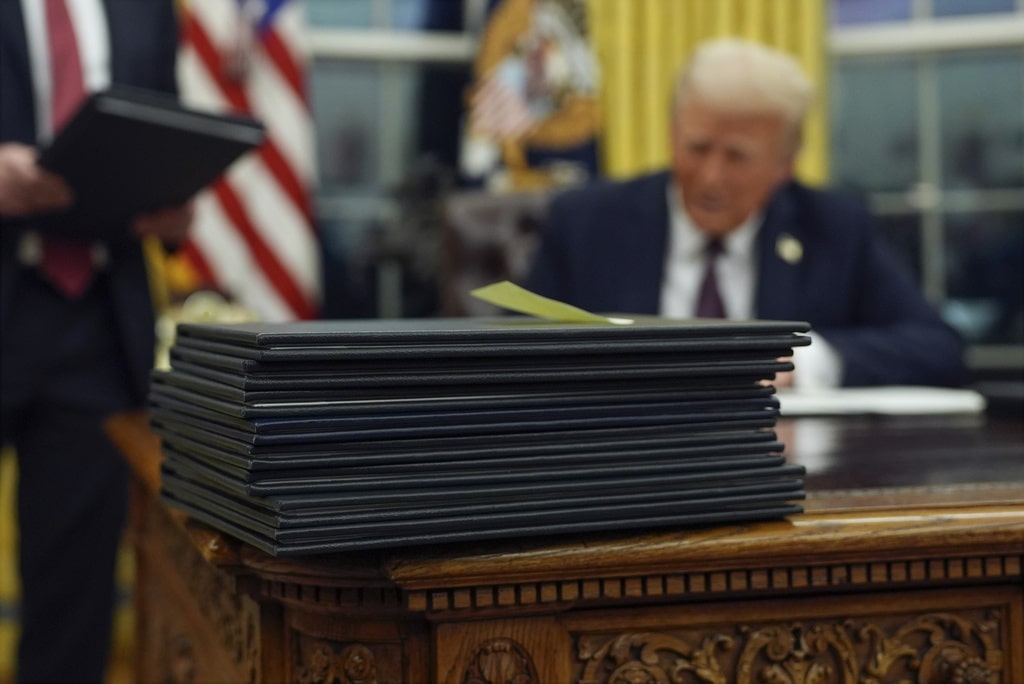It is common to observe that Congress makes the laws, the president enforces them, and the courts interpret them and decide on their constitutionality, but political practices sometimes deviate from such a clear division. Nowhere is this clearer than when it comes to executive orders.
Such written directives by the president are textually based on the provision in Article II of the U.S. Constitution that vests the president with power to “take care that the laws be faithfully executed.” This power, however, must be exercised within the confines of what the U.S. Constitution and laws adopted under its authority permit.
In cases where the Constitution vests Congress with the powers to legislate, it can overturn such orders. Such orders may also be overturned by the courts if they violate federal laws or the Constitution, and, in a trend that has increased in recent years, one president may rescind or amend an order by a previous president (Anders 2025).
Historic Executive Orders
Presidents from George Washington to the present have issued executive orders. The Federal Register now records more than 14,000 of them. Although many are fairly innocuous, others have been quite consequential. Relying upon his war powers, President Abraham Lincoln issued the Emancipation Proclamation on January 1, 1863, which was later affirmed and extended (Lincoln’s orders originally only applied only to slaves held behind enemy lines) by the 13th Amendment (1865).
President Franklin D. Roosevelt issued an executive order detaining Japanese Americans during World War II. Roosevelt also ordered the racial integration of shipyards. His immediate successor, Harry S Truman, used an order to desegregate the military. President Lyndon B. Johnson likewise imposed civil rights regulations on federal contractors (an order that Trump has rescinded in his second term).
After the terrorist attacks of Sept. 11, 2001, President George W. Bush signed an order designed to impede terrorist funding. During his first term, Trump issued orders restricting immigration from designated countries, and President Joe Biden ordered federal agencies to facilitate voter registration (Anders 2025).
At the state level, many state governors issued executive orders during the COVID-19 crisis. Courts subsequently invalidated some of these, particularly those that put greater restrictions on gatherings at religious rather than at commercial establishments.
Donald Trump’s extensive use of executive orders
During his first term, President Donald Trump signed 220 executive orders. From January 20 to April 2, 2025, of Trump’s second term, he issued 111 executive orders (EO 14147 through EO 14257), often on quite consequential matters.
An executive order that Trump issued on the first day of his second presidential term was positively entitled “Restoring Freedom of Speech and ending Federal Censorship” and pertained to social media companies. Observing that “the previous administration trampled free speech rights by censoring Americans’ speech on online platforms, often by exerting substantial coercive pressure on third parties, such as social media companies, to moderate, deplatform, or otherwise suppress speech that the Federal Government did not approve,” he directed the Attorney General to investigate such actions.
Trump has issued a number of other executive orders withholding, or threatening to withhold, funds from educational institutions that have continued Diversity, Equity, and Inclusion (DEI) programs, or that he believes have not protected Jewish students, or that he thinks have taken insufficient measures to reign in student protests. Actions directed at deporting immigrants, also prioritized in such orders, appear to have been particularly directed against students like Mahmoud Khalil of Columbia University and Rumeysa Ozturk of Tufts University, who have exercised First Amendment rights of free expression.
On March 27, 2025, Trump issued an order entitled “Restoring Truth and Sanity to American History.” It sought to prevent the display or funding of exhibits at the Smithsonian Institution that he thought “degrade shared American values, divide Americans based on race, or promote programs or ideologies inconsistent with Federal law and policy.”
Trump has issued orders denying employment or governmental contracts to law firms that have challenged governmental policies or who have engaged in DEI programs. Some of these firms have promised to provide pro bono services to the government in exchange for exempting them from such sanctions. Trump's order to end
Other orders have designated English as the official language of the United States; called for reductions of the federal bureaucracy; established a White House Faith Office; prohibited men from participating in women’s sports; declassified records related to the assassination of John F. Kennedy; declared a national energy emergency; dismantled the Voice of America; and rescinded a host of executive orders from previous administrations.
Some of Trump's executive orders have been challenged on First Amendment grounds
Many of these orders, and their implementation, are already being challenged in Court, some on First Amendment and others on Fifth Amendment due process concerns. Much will likely depend on the degree to which members of Congress support or refuse to support Trump’s actions, which may, in turn, hinge on public reactions to these orders.
Because presidents often reverse executive orders of their predecessors, such orders remain much more unstable than the Constitution to which they are subject, and the underlying laws they are reputedly designed to implement.
John R. Vile is a political science professor and dean of the Honors College at Middle Tennessee State University.

